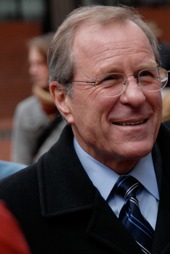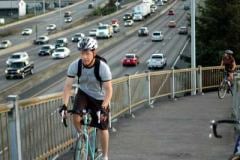
[Editor’s note: This is the first article in our new section, BikePortland.org: In-Depth.
The main contributor to this section will be Libby Tucker. Ms. Tucker is a freelance reporter whose articles have been published in a myriad of outlets including the Associated Press, MSNBC.com, The Oregonian, and others. She was most recently a staff writer for the Daily Journal of Commerce where she covered transportation, construction and energy. She is also the author of the blog, Naked Energy.
In this article, Ms. Tucker takes a closer look at how bikes figure into Governor Kulongoski’s 2009 plans.]
Hey Governor, what about bikes?
Bike advocates look for hidden benefits of Kulongoski’s proposed transportation package for 2009

Courthouse Square in April.
(Photos © J. Maus)
Even as Oregon lawmakers consider ways to lower greenhouse gas emissions and slash the state budget, Gov. Ted Kulongoski’s proposed Jobs and Transportation Act of 2009 lacks any significant new policies for bikes — the greenest, most cost-effective way to get around (especially in cities).
The word “bicycle” is mostly absent from the document, which proposes a 2-cent gas tax increase and new fees to raise another $499 million for the state highway fund. Also missing is a visionary plan to encourage cycling on the order of the proposed new $5,000 state income tax credit toward the purchase of plug-in hybrid and all-electric cars.
“The word “bicycle” is mostly absent from the document…Also missing is a visionary plan to encourage cycling.”
Instead, the $1 billion package tags $600 million in bond sales for projects that unclog freight traffic; $150 million every two years *in one-time money (that will be generated by lottery bond proceeds) for rail, aviation, transit and marine projects; $35 million toward a new Amtrak train; $6.5 million a year for cash-strapped county maintenance programs; $5 million every two years for elderly and disabled services; and a range of other proposals that attempt to make driving greener and cut congestion.
[*Update 12/5; Please note our correction in the paragraph above regarding the $150 multimodal transportation investment.]
“There’s some creative accounting, a little more money, but there’s nothing new yet (for non-auto modes),” said Rex Burkholder, a Metro councilor who helped advise the governor’s policy as a member of the transportation visioning committee.
Kulongoski’s proposal isn’t anti-bike, however, advocates and transportation planners say. Hidden programs are stashed throughout the plan that direct more state dollars to new bike projects.
For starters, the Oregon bike bill, passed in 1971, requires 1 percent of the proposed highway fund increase to be spent on bicycle and pedestrian improvements. That amounts to a $4.9 million increase in spending, or nearly 80 percent more than current state spending on bike and pedestrian improvements.

Bridge near downtown Portland.
“It’s never enough but what is being proposed is a substantial increase over what we’ve seen in the past,” said Karl Rohde, a lobbyist for the Bicycle Transportation Alliance. “We have to work really hard to constantly put the pressure on to make sure it happens.”
Without Kulongoski’s bill, the Oregon Department of Transportation estimates it will spend between $6.1 million to $6.2 million of its roughly $640 million a year highway fund revenue on bicycle and pedestrian projects each year from 2009 to 2011, as a result of the 1-percent requirement, or about the same amount the agency spends re-painting pavement markings.
From 2001 to 2005, the state failed to spend even 1 percent of highway funds on bike and pedestrian projects, according to ODOT’s 2007 bicycle and pedestrian program annual report.
Boosting the highway fund by $499 million affords bike advocates an opportunity to push for non-traditional improvements, such as bike signals and physically dividing lanes to split bike and car traffic, says Mia Birk, a transportation consultant with Alta Planning and Design.
< ?php if (function_exists('dfrad')) { echo dfrad('ad_225x225'); } ?>
“By being the eyes of the community you ensure the appropriate bikeway treatment, and that might be pushing for facilities that are way beyond what transportation officials want to do,” said Birk.
The proposal also mentions an “expanded” Transportation Options Program that includes bike and pedestrian programs, carpools and vanpools, ridesharing, and education and marketing to reduce the number of cars on the road. Specific dollar amounts for the expansion haven’t yet been drafted, however.
And as the 2009 session begins Kulongoski will likely propose an amendment to the bike bill that would increase the requirement to 1.5 percent of state highway funds towards bike and pedestrian improvements, said Hans Bernard, Kulongoski’s deputy legislative director and former transportation advisor.
All told, the package could increase highway fund spending on bike and pedestrian projects from about $6.2 million to $13.7 million a year.
“Cycling is the cheapest option we have for reducing VMT and we consistently pass over it to look at the sexier things.”
— transportation activist Chris Smith
“The governor recognizes the transportation package needs to benefit all modes and increasing bicycle mode share is a key component of that proposal,” said Bernard.
Benefits for state and local bicycle and pedestrian projects are also hidden within broader categories of the proposal. Requirements for least-cost planning and targets for vehicle miles traveled (VMT) are designed to favor walking and biking without necessarily labeling them as such, said Burkholder.
The least-cost approach to transportation planning, for example, counts carbon dioxide emissions as a cost and would therefore direct state and regional planners to invest first in bike and pedestrian projects, which carry the lowest carbon footprint.
“Event though it’s kind of buried in line items, the end result is more funding in bike and ped,” said Sheila Lyons, pedestrian and bicycle program manager for ODOT. “There’s probably plenty of money; that’s where least-cost planning could have some real exciting implications. My sincere hope is that means bikes and walking do rise to the top.”
Despite their general support for the transportation package, cycling advocates and planners remain quietly frustrated the proposal doesn’t include a bigger vision, however, especially more funding for bike projects and policies.
“Cycling is the cheapest option we have for reducing VMT and we consistently pass over it to look at the sexier things,” says Chris Smith, a Portland transportation advocate and former city council candidate. “It’s disappointing it’s not being pointed out as a policy. The governor needs to talk about it as a strategy and have some dedicated line items to address as opposed to letting funding (for bike projects) be pulled out of different pots.”
Stay tuned for more BikePortland In-Depth stories from Libby and other contributors in the weeks to come. Next up will be a closer look at the contrast of enthusiasm between bikes and Oregon’s dreams for electric cars.
Let us know what you think about this new offering. — Jonathan






Thanks for reading.
BikePortland has served this community with independent community journalism since 2005. We rely on subscriptions from readers like you to survive. Your financial support is vital in keeping this valuable resource alive and well.
Please subscribe today to strengthen and expand our work.
It is interesting that our Gov’nor is visiting Asian capitols for small funding for car vehicle production when Oregon makes more bike vehicles than car vehicles.
Given the economics of car and motor vehicle design and production…I doubt there will ever be a chance for small states to economically make cars (as a commodity vs craft)…but every large city in Oregon could make bicycles and human powered vehicles some day.
Interesting points, Racer X. Continuing along in a similar vein:
Portland, as the State’s largest city, is arguably less of a natural fit for large-scale biking than other cities. The distances are longer and the motor vehicle traffic is greater. Yet, here we are.
There are lots of smaller cities and towns across the state that would be easy places to bike around, yet hardly anyone does. Take McMinnville, for example. It’s relatively flat and compact. At ~30,000, the distances are short and traffic is relatively light. Yet the bike lanes mostly sit idle and people drive virtually everywhere, even a mile or two to the grocery store.
My point is that there is vast untapped potential for decreases in VMT throughout Oregon, not just in its notoriously bike-friendly big city.
But why don’t people bike around those places? They tell us that they don’t feel safe. That’s partly about bike infrastructure, partly about the need for additional laws to protect vulnerable roadway users, and partly about inadequate enforcement of current traffic laws. The plan does very little to address those factors.
So, when you take a moment to analyze the situation, you see that, though the Gov has thrown a few bones to cyclists, no one working on this plan really has a clue how to *really* develop the the potential of cycling to improve transportation in Oregon. It’s just as Chris Smith said (as usual).
“Cycling is the cheapest option we have for reducing VMT and we consistently pass over it to look at the sexier things”
Just take a look at
http://www.flickr.com/groups/velocouture/
and
http://www.flickr.com/groups/cyclechic/
and then tell me which is sexier – a road full of cars, or a road full of cyclists 🙂
nicely made point Dave… but I think Chris meant “sexy” in a political sense, not in a fashion or fondness sense.
yeah, I know 🙂 but still, had to make the point 🙂
Won’t it be great if someday supporting a sustainable, clean means of transportation that benefits the health of the citizens of a city, as well as their enjoyment of their city is politically sexy? 🙂
The title of this post doesn’t make any sense. I went into it thinking “oh crap, here’s the first detailed report on how we cyclists are getting screwed by the new budget.” What I read, however, says the exact opposite:
“All told, the package could [MORE THAN DOUBLE -emphasis mine] highway fund spending on bike and pedestrian projects from about $6.2 million to $13.7 million a year.
snip
The least-cost approach to transportation planning, for example, counts carbon dioxide emissions as a cost and would therefore direct state and regional planners to invest first in bike and pedestrian projects…”
That silver lining you were looking for just reached down from the sky and smacked me on the head. Seriously, what’s the problem? We’re in a recession, and the guv DOUBLES funding for cycling?
Name one other special interest that can say the new budget doubles their funding. Just one. There are political realities at play here, and while “it’s never enough” as Karl said, this is a fantastic step forward.
“Also missing is a visionary plan to encourage cycling.”
Are you sure about that? ODOT is providing a lot of money for the Bicycle Master Plan update, which I am sure will be visionary by any standard. Throw in 13 million for implementation in the first 2 years alone, and include carbon emissions in the cost benefit analysis, and I’d call that pretty darn proactive.
Jonathan, good idea on the in depth series. I would love to see this article re-written by someone who doesn’t take a cynical viewpoint.
GLV,
I’ll let Libby respond for herself, but I’d like to share a few things.
— the “could double” is far from a reality and very well might not happen. it’s based on a potential increase to the bike bill from 1% to 1.5%.
— the “least cost planning model” is just that. a planning model. it’s an idea that can be twisted and manipulated any number of ways with no guarantee that bikes will bubble up to the top.
— wholeheartedly disagree with you that this is a “fantastic step forward”.
— ODOT has given a paltry sum to the Bike Master Plan. At the last steering committee meeting (which I attended), Roger Geller himself (the man behind the effort for PDOT) kept saying how the plan is barely squeaking by “on pursestrings”. the Bike Master Plan is long overdue and is being cut short precisely because it lacks adequate funding and staff resources.
— the fact remains that the Governor has not mentioned any specific, bike-related ideas that could capitalize on the amazing strides that have been made in Oregon’s largest cities and/or that would give a major boost to the mode that is hands down the best return on investment our state can make.
thanks for your feedback on the article.
Thanks for the comments GLV. I don’t believe the article takes a cynical viewpoint. It fairly and accurately reports how much additional money would go to bike and ped improvements as a result of the Governor’s proposal. It also includes all of the other areas in the proposal that would potentially benefit bike spending. And as you point out, those are positive things. What I heard from the bike community and elected officials in the course of reporting was that they feel it falls short of a bold new vision. The story reflects that as well.
Pretty much.
Why are bike not included in a 500 million transportation spending package or $5,000 electric car subsidies? Simple – Bikes are simple cost effective transportation that do not require $500 million or subsidies. No political hay to be made here. I guess we should be thankful? While the package doesn’t have the needed 25-cent gas tax increase, I guess we should take what we can get.
“I guess we should take what we can get.”
T27,
it’s that kind of thinking from bike advocates and planners over the years that has created a country where only 1% of the people regularly ride a bike.
it seems like now is the time to not be satisfied with “take what we can get” and instead begin to demand that bikes get what they deserve.
“– the “could double” is far from a reality and very well might not happen. it’s based on a potential increase to the bike bill from 1% to 1.5%.
— the “least cost planning model” is just that. a planning model. it’s an idea that can be twisted and manipulated any number of ways with no guarantee that bikes will bubble up to the top.”
Those are factors controlled by legislators and people who will implement the legislation. The guv has made the proposals and should be commended for it.
The salient point in my comment that I did not emphasize enough is that we are dealing with political and economic realities here. I would love to see $100 million from the legislature for the Sullivan’s Gulch trail, but where’s that money going to come from? Programs are being cut across the board, yet cycling’s funding could double. (if legislators and bureaucrats don’t water down the guv’s proposal.)
Fact is we have the highest unemployment rate in the nation, and a mortgage crisis that is going to get a whole lot worse very soon. I don’t think increasing funds for cycling should be the top priority of government right now. Yet here we are, with a very significant proposed funding increase. That indicates to me that cycling is in fact rather high on the list of priorities. Anyone who won’t be satisfied until there’s a Department of Bicycles isn’t adding much to the conversation.
In fact, given the extraordinary circumstances we find ourselves in at the moment, I think it is perfectly acceptable to say “take what we can get.” How much do we “deserve,” anyway? Tripling, quadrupling, uh, quintupling of our appropriation? Try selling that to the Senator from Union County.
GLV,
i would encourage you to compare the potential increases to bike funding with the other line-items in his plan. “doubling” funding for bikes might sound great but it’s still a laughable sum of money.
Or, take a look at the electric car subsidy. Why not have a subsidy like that for bikes?
Also, a major point here is that bikes really don’t need money and big projects to thrive.
bikes could benefit greatly from new policies, not just new projects.
The governor could outline some basic policies for oregon’s cities that would clearly demonstrate a priority for bike traffic (and discourage private auto use).
how about a plan (only) in Oregon’s big cities like Eugene, Portland, Corvallis, Salem that takes a very close look at on-street parking and starts to remove it where it inhibits safe and efficient flow of bike traffic?
How about re-allocating some roadway space for larger bike lanes (like on mega-streets like MLK)?
How about a subsidy for businesses that choose to use bikes as delivery vehicles?
How about creating more carfree streets?
Also, I don’t expect rural voters or rural politicians to embrace biking as a transportation mode like voters in cities should.
the bottom line from what I’ve gathered hearing the Governor’s speeches and talking with bikey insiders is that he has said little or nothing exciting about bikes…. and he’s someone who touted bikes over the summer and who seems dedicated to “sustainability”. it’s too bad really.
I completely agree that more funding is needed for lots of transportation improvements and especially to encourage alternative modes (bicyclists and pedestrians).
What I don’t agree with is the Governor’s ideas on how to raise the money. Sixty-two percent of the annual revenue increase would come from OWNING a car (due to an increase in registration fees). Twenty-six percent would come from BUYING a car (due to increase in title fees). Less than 12 percent of the increase would come from increases associated with USING a car (gas tax increase).
The Governor’s package does include some things supposedly intended to encourage high mileage vehicles, including a half-price title fee. That would save you $50 on that one-time transaction.
A far better approach is to tax what we don’t want to encourage: USING the car. For whatever money we decide we need to accumulate for whatever purpose, we should go for a high gas tax so that people are encouraged to drive less or drive more efficient vehicle EVERY time they fill up, rather than ONCE when they consider buying a fuel efficient car. The car that’s sitting in the garage for days at a time isn’t contributing to congestion or causing much wear and tear. It’s not owning a car that causes a problem it’s using it.
So, I’m writing to the Governor to propose that all the $500 million annually come from an increase in the gas tax. That would put Oregon’s tax about on par with that in Washington. Oregon’s tax hasn’t increased since 1993, while Washington has increased theirs four times.
You can interpret the governor’s package in a variety of ways using the existing facts. The conversation here demonstrates that. It comes down to a question of expectations.
Personally, I side with Jonathan. Doubling next to nothing is still not something.
Of course the litany of justifications comes raining in… the economy, the politics of the rural legislature, and so forth.
But given how compelling the facts are in support of more investment for bikes – in urban communities for transportation and scenic rural areas for tourism, to cite just two rationales – frankly I find it deeply disappointing that the governor would choose not to employ those powerful facts.
I tend to think people overanalyze these things in search of the ‘why’. I think the ‘why’ is simple: I don’t think Kulongoski relates to the bicycle. Said another way, I don’t think he “gets” it. Intellectually, sure. That part is easy. But the personal experience? He’s never even faked it with the photo-op.
Time and again Jonathan has opined that the bicycle can – and will – be transformational when our leaders embrace its potential. I agree. But I’ve come to realize of our elected leaders that if you don’t ride, you don’t understand the potential to transform.
Ask Jackie Dingfelder to speak her heart about the proposed “big” move (ha ha) from 1% to 1.5%. Not that you’d hear it – she’s an elected official – but if you did, Jackie would probably tell you it should be 5%. And that we should figure out how to embrace the distinct realities that are urban and rural so that these precious dollars can be spent in strategic ways. Jackie rides. A lot. She “gets” it.
It’s okay to have the glass half full perspective on this. But my problem with that is I don’t think it ever amounts to much. You’ll never come close to tapping the immense – no hyperbole – transformational potential of the bicycle.
Oh, and that 2-cent gas tax increase? That’s Oregon’s local match contribution for the $4 billion 12-lane superhighway to assuage sprawl in SW Washington. Mark these words.
I like the addition of in-depth reporting — please keep it up.
“From 2001 to 2005, the state failed to spend even 1 percent of highway funds on bike and pedestrian projects, according to ODOT’s 2007 bicycle and pedestrian program annual report.”
Does this mean ODOT violated the law? Is anyone planning to take the arrears — i.e. the accumulated money that was supposed to have been spent on bike infrastructure but wasn’t — and carry them over to the next budget cycle or two IN ADDITION TO the 1 or 1.5 percent portion for those cycles?
Jonathan, I like your “how abouts” in post 14 above, and I’m sure that’s just the top of the list that you and others here could propose. Is the BTA or anyone else putting together model legislation — a true bike bill — that would incorporate those and other pro-bike policies for the next session? Have they identified legislators who’ll consider sponsoring such legislation? Seems like those policies would dovetail well with the Gov’s philosophy, if not his proposed budget. Maybe an upcoming in depth report could focus on those questions.
Visionary proposals make their way into budgets because an effective advocate or lobbyist pushes them onto the agenda. I’d love to hear more about how bike advocates are planning to do that for the next legislative session.
Thanks again for the informative report.
Great article. I, too, find the 2-cent gas tax increase pretty pathetic, but rather than propose an increase, it’s time to change the structure of the gas tax. Currently, since the tax is calculated by the quantity of gas purchased, when market forces increase the price of gas, people drive less — which is good — but transportation revenues go down — which is bad. I’d like to see the tax put on each dollar of fuel purchased, which means that the the tax per gallon goes up as the price goes up, partially offsetting the reduction in gas sold. It would make a much more stable platform on which to build a sensible transportation funding structure, one that isn’t invested in keeping everyone driving. And, we wouldn’t get highly disappointing — and absurd — results like the cancellation of the Flanders Street (car-free) Bridge because people were driving less!
Jonathon and Libby, thanks for the article.
Least cost planning does not necessarily favor self-propelled transport. If you do not believe the walking and biking are viable ways of reducing VMT and carbon emissions, then the least cost approach would be eliminate anything that impedes cars or adds unnecessary costs to right-of-ways being modified for cars.
For example take the CRB, if self propelled transit is going to be 1 or 2% of the traffic on the bridge but add 5% to the cost, it is entirely possible to argue that the least cost design is to reduce provisions for self-propelled transport. It would entirely depend upon the arbitrary value assigned to the carbon emissions.
The problem with ODOT’s 1% for bikes is that it must be spent in the right of way of the road project…hence we get bike lanes on Barbur, St Helen’s Road, TV Highway, etc., all of which are pretty unpleasant additions to the bike network. Or we get a bike/ped path next to a freeway…yuck! Bicycle transportation option needs to be called out, and a state bike network funded above and beyond the 1%. Note that ODOT spends now $600M each year! That should be enough.
The bottom line is that the Bicycle Bill is in dire need of some help.
No one has ever done a complete audit and it hasn’t changed one iota in over 30 years.
One of my ideas is that the Bike Bill money should go into a pot that should be overseen and doled out by a committee of experts, community members, agency stakeholders, etc…
That way, the Bike Bill will provide strategic investment instead of just bike lanes on major arterials and other uncreative facilities.
A perfect example is Naito Parkway which was just completely rebuilt. We have nice bike lanes on it now… but we should have a separated path (cycle track)… especially on the Waterfront Park side. A missed opportunity for sure.
Those are all great ideas Jonathan, and I would support them, especially the bike delivery subsidy idea. That’s a missed opportunity, for sure. However, I don’t think it’s the state’s role to micromanage the right of way on city streets. Currently, ODOT has little to no say on how cities manage their streets unless, like MLK or Powell, it doubles as a state highway. State involvement in many of the ideas you presented would represent a major power grab. The Big Look Task Force is moving toward local control, not away from it.
For example, I don’t see any existing policy prohibiting the cities you mentioned from removing on street parking to facilitate bike movement. We are already replacing car parking in PDX with bike parking, so it’s not hard to imagine the city, with no state involvement at all, taking it a step farther.
Ditto car free streets: as long as there isn’t a “significant impact” to a state highway, there is nothing preventing a city from creating one (or several). Anything on MLK, unfortunately, would require direct involvement of ODOT and is therefore very unlikely. But do we need that? There are fantastic bikeways a few blocks away on either side.
I guess I just fundamentally disagree that the absolute increase in funding is what’s important; I think a large relative increase, especially in this budget, is a good thing.
Why not title the article “Kulongoski proposes first increase to Bike Bill funding since it was passed three decades ago” ? It’s true.
Thanks again GLV for your comments.
I understand about local vs. ODOT control of projects. My thoughts about the Governor were not that he could force the hand of cities but that he could have given them the political cover/opportunity to do those things (which are sometimes controversial).
I think we can agree to disagree about the level of optimism with this proposal.
When I read that there’s no line item funding for bikes and that there’s $15 million to continue with planning for the CRC (for just one example)… it causes me concern.
And you’re right that we could have used that title. We could have used any number of titles.
Again, thanks for the feedback. also, I’ll be following this story up today or tomorrow with a sneak peek at the latest draft of the Governor’s plan that includes more details on potential bike funding (the document was obtained by Libby Tucker during her research for this story).
cheers.
Many more people than the governor don’t get the importance of the bike to a more livable environment. The state needs to do a better job of establishing and broadening awareness of the fact that bicycles are an increasingly important transportation part of the transportation picture.
If Oregonians widely recognized that the people on bikes they were sharing the road with were regularly using the bicycle to put bread on the table, then the approach to bike/pedestrian improvements might be a lot different than it is today.
Money for bike/pedestrian infrastructure improvements would be far more forthcoming if Oregon residents understood that the money could make walking or biking in their cities downtowns a practical, safe reality.
I agree with Jonathan that it would have been nice to have, at a state level, even the statement that cycling infrastructure is an important piece of our efforts to make our state more environmentally friendly, economically viable, and citizen-friendly. The plan doesn’t have to outline all the individual projects that will happen in the future, but it could give dedicated funding and policy support to cities that wish to increase their biking potential.
Correct me if I am wrong, but I believe the state constitution requires that all gas tax and auto fees be spent ONLY in the ROW; this includes the 1% for bike/peds which restricts where and how those funds are spent. i.e bike lanes on St Helens Road can be funded, but not a Greenway Trail parallel to but some distance away from St. Helens Road.